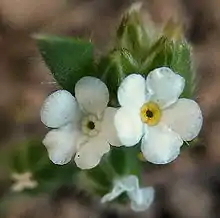| Plagiobothrys canescens | |
|---|---|
 | |
| Scientific classification | |
| Kingdom: | Plantae |
| Clade: | Tracheophytes |
| Clade: | Angiosperms |
| Clade: | Eudicots |
| Clade: | Asterids |
| Order: | Boraginales |
| Family: | Boraginaceae |
| Genus: | Plagiobothrys |
| Species: | P. canescens |
| Binomial name | |
| Plagiobothrys canescens | |
Plagiobothrys canescens is a species of flowering plant in the borage family known by the common name valley popcornflower.[1] It is endemic to California, where it is a common wildflower in valley, foothill, desert, coastline, and canyon habitat in the central and southern regions of the state.
Plagiobothrys canescens is an annual herb with a spreading or erect stem 10 to 60 centimeters in length. The leaves are located in a basal rosette about the base of the stem, with smaller ones located along the stem's length. The plant is coated in long, rough hairs and sometimes bristles. It is purple-edged and -veined and leaks purple juice when crushed. The inflorescence is a series of tiny flowers and hairy bracts. Each five-lobed white corolla measures 2 to 3 millimeters wide. The fruit is a rounded, arched nutlet no more than 2 millimeters long textured with cross-ribs.
References
- ↑ USDA, NRCS (n.d.). "Plagiobothrys canescens". The PLANTS Database (plants.usda.gov). Greensboro, North Carolina: National Plant Data Team. Retrieved 31 January 2016.
External links
- Jepson Manual eFlora (TJM2) treatment of Plagiobothrys canescens
- Plagiobothrys canescens Photo gallery
